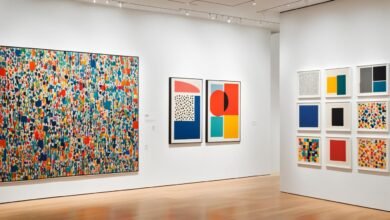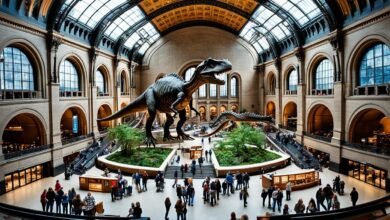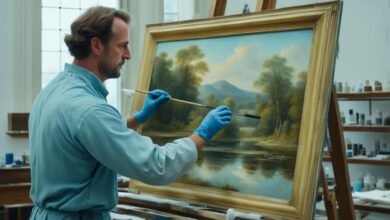Table of Contents
Have you ever dreamed of stepping into medieval Europe? The Cloisters in Fort Tryon Park, Upper Manhattan, lets you do just that. This part of the Metropolitan Museum of Art offers a peaceful getaway. It takes you back to ancient times. You’ll see the famous Unicorn Tapestries and a beautiful medieval garden, all with stunning views of the Hudson River.
Walking into The Cloisters, you’re greeted by ancient European architecture. You’ll wander through courtyards that look like old monasteries and see castles. There are also beautiful stained-glass windows and impressive doorways leading to sacred spaces. Every direction you look offers a glimpse into the Middle Ages.
Inside The Cloisters, you’ll find amazing medieval art and objects. Look at the tombs of 14th-century Catalan nobles. Admire the stained-glass windows showing saints and biblical scenes. The art gives you a peek into the Middle Ages’ rich cultural legacy.
The beauty of The Cloisters goes beyond its walls. The gardens take you back in time. They’re part of Fort Tryon Park, a peaceful place with amazing Hudson River views. The Judy Black Garden is like those from medieval times, filled with lovely smells and sights. Then there’s the “Bonnefont” Cloister Garden, with herbs from medieval gardens. Don’t miss the Trie Cloister Garden, inspired by the Unicorn Tapestries, with colorful plants and a fountain.
Going to The Cloisters isn’t just about seeing art and buildings. It’s also a chance to learn about medieval art and music. Find out how artists in the Middle Ages used music, incense, and light to make beautiful experiences. Dive into the storytelling of the art, learning about the culture and history of that period.
At The Cloisters, you travel back in time and discover the Middle Ages’ rich culture. This visit can change how you see the world. It shows you the lasting impact of human creativity. Are you ready for this amazing journey?
The History and Construction of The Cloisters
The Cloisters in New York is nestled in Fort Tryon Park. It’s a famous museum devoted to medieval art. Learning about its history and how it was built adds to its charm.
In 1933, The Cloisters started to take shape in Fort Tryon Park, upper Manhattan. The goal was to make a museum that felt like medieval Europe. It features real pieces from old monasteries, churches, and castles.
Despite tough times due to war and economic trouble, the builders kept going. They turned their dream into something real. Now, it’s a quiet haven for those who love medieval art.
The Cloisters is a nod to the beauty of medieval Europe architecture. It shows what people can do, even when times are hard.
Construction Highlights:
- Original elements from medieval European structures were used in the construction
- Design aimed to evoke the architecture and atmosphere of the Middle Ages
- Construction began in 1933 in Fort Tryon Park, New York
A Closer Look at The Cloisters:
Exploring The Cloisters means diving into its building brilliance. We’ll see amazing architecture and the skill it took to make it a standout place.
| Architectural Features | Description |
|---|---|
| Medieval Monastic Cloister | Authentic medieval cloister sourced from Saint-Michel de Cuxa in France |
| Castle Rooms | Reconstructed spaces showcasing courtly scenes and architectural grandeur |
| Chapel | A sacred space featuring stunning stained-glass windows and intricate stone carvings |
| Courtyard | A tranquil outdoor space reminiscent of medieval gardens |
The features of The Cloisters show the many sides of medieval life. From holy worship to royal elegance, it’s all there. Each part of the museum is a gem to be found.
Walking through The Cloisters, take time to see the fine details of the medieval period. Notice the stained-glass windows and the stone carvings. Each piece has a story and takes you back in history.
Quote:
“The construction of The Cloisters was a labor of passion and dedication, capturing the essence of medieval Europe and bringing it to life in the heart of New York City.” – Architecture Enthusiast Magazine
Exploring The Cloisters: A Journey Through Time
When you visit The Cloisters in New York, you step back into the medieval world. This museum is in Fort Tryon Park. It shows off Europe’s medieval architecture, like castles and churches.
Three Paths, Three Marvels
At The Cloisters, there are three paths to explore. Each one shows a different side of medieval art and architecture. Let’s see what each path has for us:
- The Monastery Path: Walk into the Saint-Michel de Cuxa courtyard. It’s filled with pink marble and images. This place feels just like an old monastery.
- The Castle Path: This path shows the beauty of court life in old castles. It feels like you’re stepping into a grand, royal world.
- The Church Path: This path is all about the beautiful stained-glass windows. Their vivid colors and details make you feel like you’re in a medieval church.
- The Portal Path: Walking through the Moutiers-Saint-Jean doorway is special. It feels like starting a spiritual trip into the medieval era.
Each path at The Cloisters shows a different aspect of the medieval world. You might like the calm of monasteries, the grandness of castles, the beauty of churches, or the meaning behind portals. There’s magic here for everyone.
Wandering through The Cloisters, you’ll feel like you’re in a world of knights and princesses. The museum paths lead you on an exciting trip through medieval life.
“The Cloisters takes you back to medieval times. You’ll see amazing architecture and art. Exploring paths like the Monastery, Castle, Church, and Portal, you uncover the secrets of medieval Europe.”
Marveling at the Art and Artifacts in The Cloisters
The Cloisters in New York, inside Fort Tryon Park, is an amazing museum of medieval art. It takes you back to the time of European medieval art. The museum holds a vast collection of art and artifacts from the Middle Ages.
As you explore the museum, you’ll see beautifully decorated tombs, like the tomb of a 14th-century Catalonian nobleman. These tombs show off the skill and art of that time. They amaze visitors with their details and historical importance.
The Cloisters’ stained-glass windows are stunning. They fill the museum with bright colors and soft light. The windows tell stories of saints and biblical tales. They transport you to a world full of faith and wonder. Each window brings medieval stories to life in a beautiful way.
At The Cloisters, you can also see special exhibits about the Middle Ages. You’ll find everything from fancy religious altarpieces to beautiful illuminated manuscripts. Each piece carries a bit of history, making you think and appreciate more.
“The art and artifacts in The Cloisters are more than mere objects. They are windows to a bygone era, gateways to understanding and connecting with the spirit of the Middle Ages.”
Discover the artistry of the past at The Cloisters. Every artifact shows the talent, creativity, and dedication of those who made them. They capture the spirit of a lively and changing time.
The Cloisters: Art and Artifact Highlights
| Artwork/Artifact | Description |
|---|---|
| The Catalonian Nobleman’s Tomb | A highly decorated tomb sculpted in the 14th century, showcasing the grandeur of medieval funerary art. |
| Stained-Glass Windows | Colorful and intricate windows depicting scenes from religious narratives, filling the museum with a vibrant glow. |
| Religious Altarpieces | Elaborate and ornate altarpieces that were once the focal point of medieval churches, illustrating the devotion and religious fervor of the time. |
| Illuminated Manuscripts | Exquisite books adorned with intricate illustrations and calligraphy, preserving the sacred texts and literary works of the Middle Ages. |
| Sculptures and Statues | Carved figures depicting saints, angels, and iconic religious figures, showcasing the mastery of medieval sculptors. |
The Tranquil Gardens of The Cloisters
The Cloisters in New York has enchanting medieval gardens. They offer a unique experience that takes you back to the Middle Ages. Located in Fort Tryon Park, these gardens showcase life, beliefs, and nature connections from that time.
Enter the Adventure Garden in Fort Tryon Park and enjoy its scenic views. Lush green paths lead you into the beauty of The Cloisters. Take time to enjoy the peace in this serene place.
The Judy Black Garden is inspired by medieval pleasure gardens. You’ll find flowers selected for their beauty and scent here. The garden’s paths let you explore vibrant colors and lovely smells. It’s a journey that brings medieval life’s essence to your senses.
The “Bonnefont” Cloister Garden overlooks the Hudson River. It showcases herbs and plants from medieval times, organized by their uses. This teaching garden tells the stories of each plant. You’ll learn about their role in medieval gardens as you walk.
In the Trie Cloister Garden, you step into a scene from the Unicorn Tapestries. The plants from these tapestries surround you. This creates an experience that mixes art with reality. Let the garden’s colors and magical feel spark your imagination.
The Cloisters’ gardens in New York offer a peaceful escape from the city. From the Adventure Garden’s landscapes to the Judy Black Garden’s blooms, each garden has its charm. The “Bonnefont” Cloister Garden’s herbs convey history, while the Trie Cloister Garden invites fantasy. These gardens connect you to the past and nature’s beauty in an unforgettable way.
Fort Tryon Park: The Adventurer’s Park
Located in Upper Manhattan, Fort Tryon Park is an adventurer’s dream. It offers stunning Hudson River views and the Palisades. You’ll find yourself surrounded by New York’s natural beauty.
The park’s highlight is the Heather and Alpine Gardens. The famous Olmsted brothers designed it. These gardens bloom with colorful flowers all year. They create a peaceful escape from city life.
Enjoy the fresh air and gorgeous Hudson River scenes. Fort Tryon Park invites you to relax or explore its paths. Its peaceful setting will refresh you.
Looking for fun? The park has lots to do. Hike, bike, or picnic with loved ones. You can even play soccer or softball on its fields.
The park isn’t just for fun. It also holds The Cloisters, a museum with medieval art. Explore its beauty, then stroll the park. It’s a perfect way to ponder art and history.
The Highlights of Fort Tryon Park
- Breathtaking views of the Hudson River and the Palisades
- The Heather and Alpine Gardens, a colorful oasis
- Trails for hiking, biking, and exploring
- Expansive lawns for picnics and relaxation
- Sports fields for friendly competitions
Fort Tryon Park satisfies all. It’s ideal for nature lovers or adventure seekers. Discover its tranquility and hidden gems. This park will meet all your expectations.
Judy Black Garden: The Garden of Paradise
Step into the Judy Black Garden in Fort Tryon Park and feel like you’re in a medieval pleasure garden. It’s a place filled with the beauty and smells from the Middle Ages. You’ll feel peace and joy here.
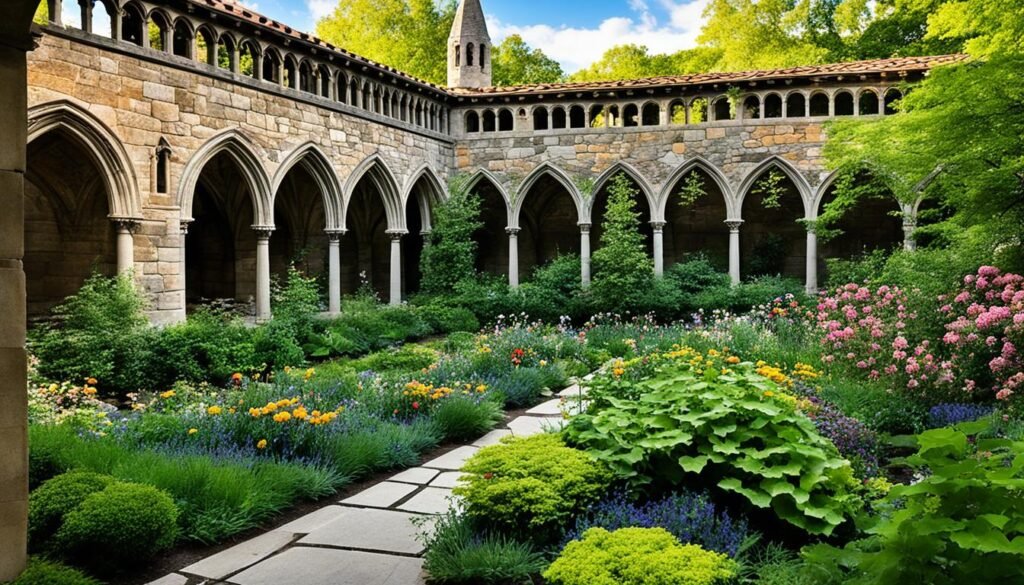
Every plant and landscape feature in the Judy Black Garden was chosen with care. They bring back the spirit of a medieval paradise. As you walk along the paths, a mix of colors and fragrances will excite your senses and spark your imagination.
A Feast for the Senses
The Judy Black Garden invites you to uncover its beauty and secrets. With each season, it offers new flowers, leaves, and fruits. This ensures a constant display for your eyes and a feast of smells all year round.
“The Judy Black Garden shows the beauty of medieval pleasure gardens. Nature thrives here, keeping ancient traditions alive. Enter this garden of paradise, and it will take you back to a magical, calm time.”
Let the scent of flowers surround you in this peaceful spot. Sit on a stone bench, soak up the sun, and let the breeze whisk your worries away.
Reflect and Retreat
The Judy Black Garden leads to The Cloisters. It prepares you for a journey of discovery, reflection, and cultural immersion.
In the garden, think about the medieval stories told through art and architecture at The Cloisters. Let the garden’s sights, sounds, and smells guide you to understand the Middle Ages better.
Find paradise at the Judy Black Garden. It will captivate your senses and show you beauty and tranquility.
“Bonnefont” Cloister Garden: The Teaching Garden
The “Bonnefont” Cloister Garden is nestled in the scenic Fort Tryon Park. It gives visitors a peek into a medieval garden’s world. Here, you’ll find a variety of herbs and plants that were essential back then.
This garden showcases the deep botanical knowledge and artistic creativity of the Middle Ages. It acts as an outdoor classroom. People learn about plants’ many uses during the medieval period, including their roles in art, cooking, medicine, and magic.
While exploring, you’ll come across about 300 different plant species. Each has its unique story and purpose. The garden features aromatic herbs for cooking and healing, and beautiful flowers valued for their looks.
Visiting the “Bonnefont” Cloister Garden offers a special sensory journey. The pathways lead you through lovely scents like lavender and rosemary. And the sight of blooming flowers takes you back to a time of peace and natural beauty.
A Teaching Garden Infused with History
The “Bonnefont” Cloister Garden is more than just pretty scenery; it’s a learning experience. You’ll see plaques and signs explaining the history and importance of the plants. This informative aspect turns a garden walk into a valuable lesson on medieval culture.
“The ‘Bonnefont’ Cloister Garden brings history to life, showcasing the interconnectedness between humans and plants in the medieval world. It’s a living testament to the wisdom and ingenuity of our ancestors.”
– Garden Enthusiast Magazine
A Haven for Medicinal Plants
Medicinal plants were key in medieval life, and the “Bonnefont” Cloister Garden honors this tradition. Here, you can find herbs and plants used for healing. Medicinal herbs, like calming chamomile and energizing sage, reflect the garden’s healing legacy.
The garden is a peaceful retreat for anyone interested in herbal remedies or nature’s beauty. It connects us with history, shows us ancient knowledge, and highlights our bond with nature.
| Experience the “Bonnefont” Cloister Garden: |
|---|
| Immerse yourself in the beauty of a medieval garden |
| Learn about the historical and cultural significance of plants |
| Discover the medicinal properties of herbs and plants |
| Enjoy the serene and tranquil atmosphere |
Trie Cloister Garden: A Fantasy Garden
Step into the magical Trie Cloister Garden. It’s inspired by the famous Unicorn Tapestries. This garden is in Fort Tryon Park. It feels like a leap into a fantasy world. There are bright colors, playful plants, and a fountain that seems to bring tapestries to life.
When you enter, a burst of flower colors greets you. It’s like a living painting, echoing the Unicorn Tapestries’ beauty. The vibrant plants stir a sense of wonder.
At the garden’s heart is a fountain. It echoes the magic of the tapestries, with sounds and splashes that soothe. This creates a calm, magical space for everyone.
If you love art or gardens, this place is a must-visit. It lets you dive into a tapestry-inspired fantasy. Here, surrounded by a lush meadow and calming fountain, you’ll find a unique escape within Fort Tryon Park.
Don’t stop here. Explore more at The Cloisters. It’s full of medieval art and culture. Let it take you to another world.
Exploring the Art and Music of the Middle Ages
The art and music of the Middle Ages are truly captivating. They offer a glimpse into the past culture and creativity. At The Cloisters in New York, you can explore this magical world of medieval art, music, and tales.
When you visit The Cloisters, it feels like stepping back into a time of knights and castles. The artworks show the incredible skill of medieval artists. Their creations still amaze people today.
At The Cloisters, you’ll see awesome medieval art. This includes statues, colorful stained-glass windows, and amazing manuscripts. Each artwork tells its own story. They talk about religious events, myths, or historic people.
Art wasn’t the only way to tell stories. Music was essential in medieval life. Imagine hearing monks chant or troubadours sing as you look at the art. These sounds made the spiritual and social life richer back then.
The Art of Storytelling
Medieval art told stories through pictures. The artists used bright colors and symbols to show different tales. People back then could understand these stories easily.
Like a troubadour’s tale, medieval art shared stories. Artists invited people to explore history and imagine.
As you explore The Cloisters, look closely at the art. Try to figure out what stories they are telling. Every carving and brushstroke shares a piece of history and a story to be found.
Sensory Experiences
Medieval art was meant to be experienced with all senses. Artists used music, incense, and light to make art more alive. They wanted people to feel the art, not just see it.
Imagine standing before a colorful stained-glass window at The Cloisters. Close your eyes and let the light and medieval music fill your senses. This takes you back to when such windows lit up churches and castles.
Visiting The Cloisters to see medieval art and music is like a magic trip to the past. It’s a chance to touch the creativity and stories of a fascinating time.
So, let yourself dive into the past. Let the art and music sweep you off to a time long gone.
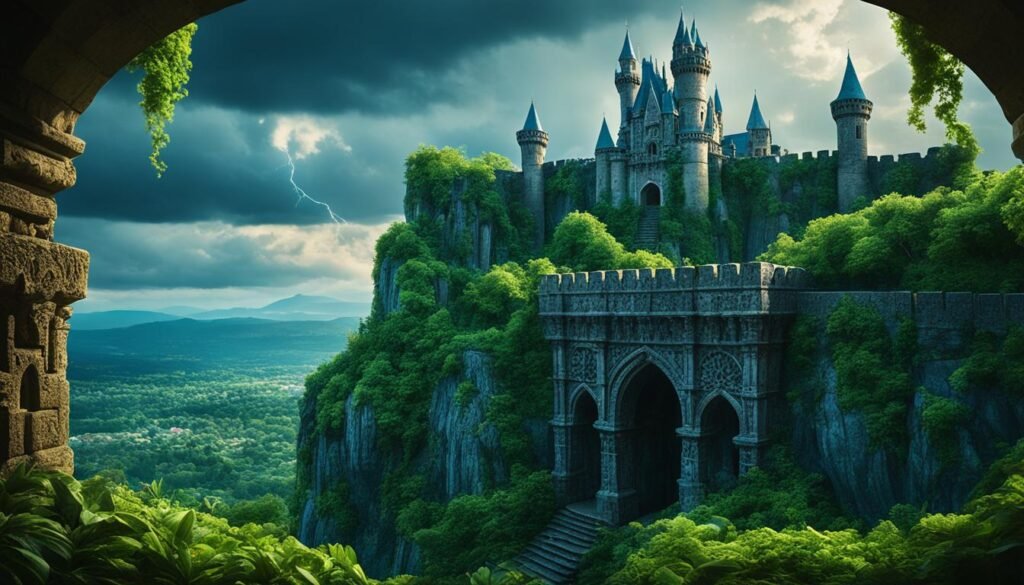
A Reflection on the Cloisters Experience
Visiting The Cloisters in New York isn’t just a museum trip. It’s a deep dive into the past, letting you grasp the Middle Ages’ history and culture. When you enter the museum, you find yourself in a medieval European setting. You’re surrounded by the beauty of Fort Tryon Park and the peaceful Hudson River.
Walking through the museum and its gardens is an adventure for your senses. You’ll feel closer to people from history. Whether it’s exploring the medieval garden, admiring the stained-glass windows, or enjoying quiet moments, each activity connects you with the past. This deep dive into medieval life and culture helps bring cultures closer. It breaks down walls between then and now.
The Cloisters in New York is more than a place for art and artifacts. It’s a space where you’re pushed to see humanity from a broad perspective. It encourages you to think about how our world compares to the Middle Ages. This helps you treasure the diversity and richness our history brings. If you’re up for a life-changing journey, The Cloisters is waiting. This immersive experience will expand your views and give you a deep connection to our collective past.

